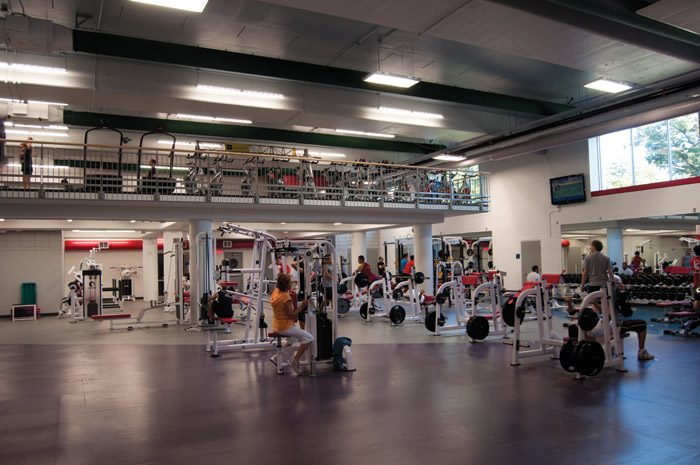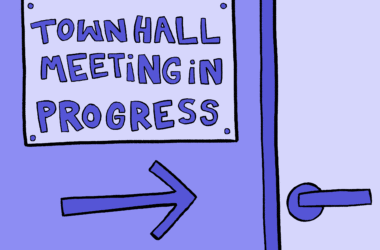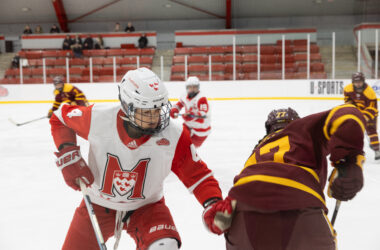All McGill students, whether they are varsity athletes or not, pay the McGill Athletics and Recreation Fee. Full time undergraduate students pay $130.83 a term, and part-time students pay $79.13. Undergraduate students also contribute to the Athletics and Recreation Facilities Improvement Fee. The Athletics and Recreation fee is one of the largest student fees, and it caused controversy among members of the Post-Graduate Students’ Society (PGSS) in 2013 when Athletics asked for a fee increase. Little public information exists on exactly how the fee operates, and how it benefits McGill Athletics and the wider McGill student population
McGill Athletics and Recreation fee
McGill Athletics and Recreation has an overall operating budget dedicated to the running of various programs, maintaining and running their various facilities and programs, and paying staff salaries. According to Philip Quintal, interim executive director of McGill Athletics and Recreation, the McGill Athletics and Recreation Fee contributes 64 per cent of the revenue stream that goes directly into the operating budget, which is then used to carry out Athletics’ general operations.
“The athletics fee, as our other revenues do, [contributes] to the day to day, overall running of our Athletics and Recreation operations,” Quintal explained. “It helps us with our programming, with our facilities, our maintenance issues [….] Right now, our net gains from […] our athletics fee is roughly just a little over $7 million.”
McGill Athletics also provides a number of jobs for students. The Athletics fee contributes to the payroll for university students to work.
“We have always tried to […] provide work opportunities for our McGill university students,” Quintal explained. “[That] goes hand in hand with running [Athletics’] programs and opening our building to our students.”
Other sources of revenue for the operating budget
McGill Athletics has revenue streams outside of the Athletics fee. Athletics works throughout the year to ensure that they are getting enough revenue to fund their facilities and operations.
“If you were just to take our payroll, our full time staff, our full time payroll, and you took the money to run all of our buildings […] only those two factors combined are right around $9 million,” Quintal explained. “We have to have a very good plan put forward to try and generate revenues to keep the place running […] there are many other things that contribute towards that budget [for example] buying equipment, the travel of some of our teams.”
Part of this additional revenue comes from renting out facilities, selling gym memberships and providing services and programs to the general public and students alike. Members of the public pay $76 a month for access to the sports complex and fitness centre while undergraduate McGill students pay $32 a semester for access to the fitness centre.
“We sell memberships, students pay fees to participate in intramural programs,” Quintal said. “If you take a fitness and recreation course, there is a fee to participate in that course […] we sell a small fitness centre membership that we collect from our students.”
McGill also makes money from varsity sports on game day by selling tickets and refreshments. On these days, you can also see some of Athletics’ corporate sponsors, such as Dominos Pizza, or Peel Pub.
“We got out and we try as much as possible to market some of our programs so that we have corporate sponsorships on the outside,” Quintal said.
According to Doug Sweet, director of internal communications at McGill, Athletics also receives money from the Quebec government but no funds from the operating budget are earmarked for Athletics
“McGill receives $2.5 million per year from the government of Quebec for services to students,” Sweet wrote in an email to the Tribune. “[Seventy-five] per cent of that goes to Student Services; 25 per cent goes to Athletics. McGill’s central operating budget does not contribute to Athletics.”
“[We] also have a transfer from the university that helps to cover the fact that we […] [house] the [Department] of Kinesiology and Physical Education […] [as well as] housing exams,” Quintal said. “That fee over the years has been reduced, but there is still a fee towards that.”
Why would Student fees increase?
In 2014 the McGill Athletics and Recreation fee increased to account for various rising costs.
“Energy costs always go up,” Quintal explained. “Salaries, whether they are mandated by collective agreements, whether it is university salary policy, [increase]. The maintenance of our facilities, because some of our facilities are older, […]require more and more financial input.”
For the Athletics fee to increase, a referendum question must be brought to the Students’ Society of McGill University (SSMU) Legislative Council.
“Our Internal Regulations […] say that if the University wants to increase an ancillary fee, I […] am obligated to bring a motion for a referendum question to Legislative Council,” wrote Zachariah Houston, SSMU vice-president (VP) Finance, in an email to the Tribune. “The Legislative Council would then decide whether or not to send the question to referendum [….] I will note that in recent years, Council has always decided to put questions on increases to ancillary fees forward to referendum and allow the SSMU membership at large to decide.”
The Athletics & Recreation Facilities Improvement fee
This fee, renewed in 2014, is separate from the primary Athletics and Recreation Fee and does not contribute to Athletics’ operating budget. Instead it is earmarked is for the improvement of athletics facilities for McGill Students. According to Quintal, students contribute $432,000 a year to this fee, a figure matched by the University.
“[Some] examples of the athletic improvement fee over the last little while [are] changing the turf on Molson Stadium,” Quintal said. “We are […] putting in a new surface [on Forbes Field]. We are also doing a face lift on our tennis courts [….] [Recently], the expansion of our Fitness Centre and the addition of the mezzanine level with […] additional equipment […] came from [the improvement] fee.”
According to Houston, SSMU is not involved in the decisions regarding the use of the improvement fee.
“In terms of involvement, the SSMU is not actively involved in decisions regarding the use of the fee–since the fee is a McGill fee, the revenue does not go through the SSMU,” Houston said.
Communication with students
McGill Athletics and Recreation aims to consult students to improve its services.
“We are always trying to communicate with the students,” Quintal explained. “In some of our advisory board meetings […] it came forward to us that students needed more space to meet to study […] we redesigned [the mezzanine of Tomlinson Hall] with some new tables where groups of students can meet.”
Athletics also sends out an annual survey to varsity athletes asking about satisfaction with the various Athletics services.
According to Houston, Athletics has not reached out to SSMU this year for consultation.
“During my term, McGill Athletics has not reached out to SSMU for student opinions regarding the use of the Athletics and Recreation Facilities Improvement Fee, nor the Athletics Fee,” Houston wrote. “Of course, I cannot speak to whether or not they have done consultation with SSMU in the past. Also, we do receive a monthly report with some very minimal information regarding how the Athletics and Recreation Facilities Improvement Fee is being used.”
Looking forward
Although its implementation has not been very well publicized, the student fee is an integral part of Athletics and Recreation. As budget cuts continue to hit Quebec universities, these fees may become topics of discussion once more. It is important that students understand both how their fees are being used and the avenues through which McGill Athletics and Recreation engages student needs and wants.









